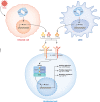Viral recognition and the antiviral interferon response
- PMID: 37367474
- PMCID: PMC10350828
- DOI: 10.15252/embj.2022112907
Viral recognition and the antiviral interferon response
Abstract
Interferons (IFNs) are antiviral cytokines that play a key role in the innate immune response to viral infections. In response to viral stimuli, cells produce and release interferons, which then act on neighboring cells to induce the transcription of hundreds of genes. Many of these gene products either combat the viral infection directly, e.g., by interfering with viral replication, or help shape the following immune response. Here, we review how viral recognition leads to the production of different types of IFNs and how this production differs in spatial and temporal manners. We then continue to describe how these IFNs play different roles in the ensuing immune response depending on when and where they are produced or act during an infection.
Keywords: Interferon; Interferon Regulatory Factor 3 (IRF3); Interferon induction; viral recognition.
© 2023 Aarhus University. Published under the terms of the CC BY NC ND 4.0 license.
Conflict of interest statement
The authors declare that they have no conflict of interest.
Figures



References
-
- Akira S, Uematsu S, Takeuchi O (2006) Pathogen recognition and innate immunity. Cell 124: 783–801 - PubMed
-
- Alexopoulou L, Holt AC, Medzhitov R, Flavell RA (2001) Recognition of double‐stranded RNA and activation of NF‐kappaB by toll‐like receptor 3. Nature 413: 732–738 - PubMed
-
- Au WC, Moore PA, LaFleur DW, Tombal B, Pitha PM (1998) Characterization of the interferon regulatory factor‐7 and its potential role in the transcription activation of interferon a genes. J Biol Chem 273: 29210–29217 - PubMed
Publication types
MeSH terms
Substances
LinkOut - more resources
Full Text Sources
Medical

